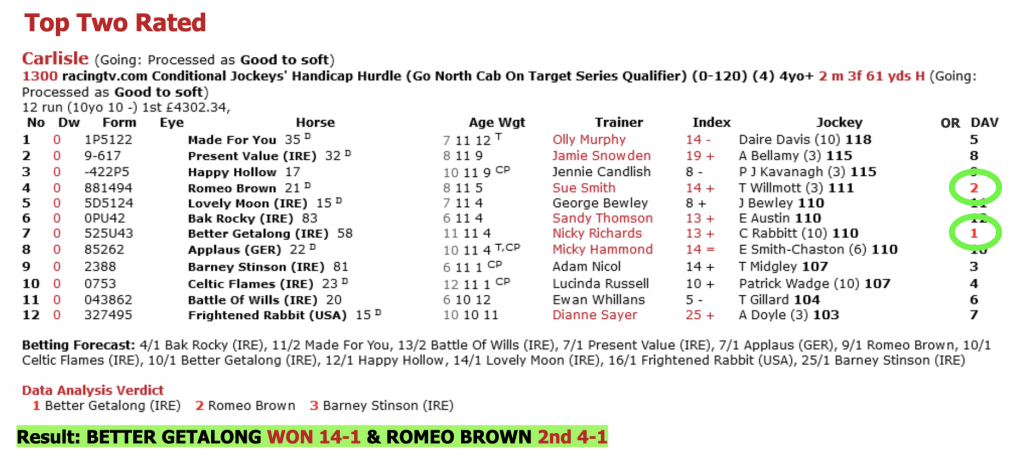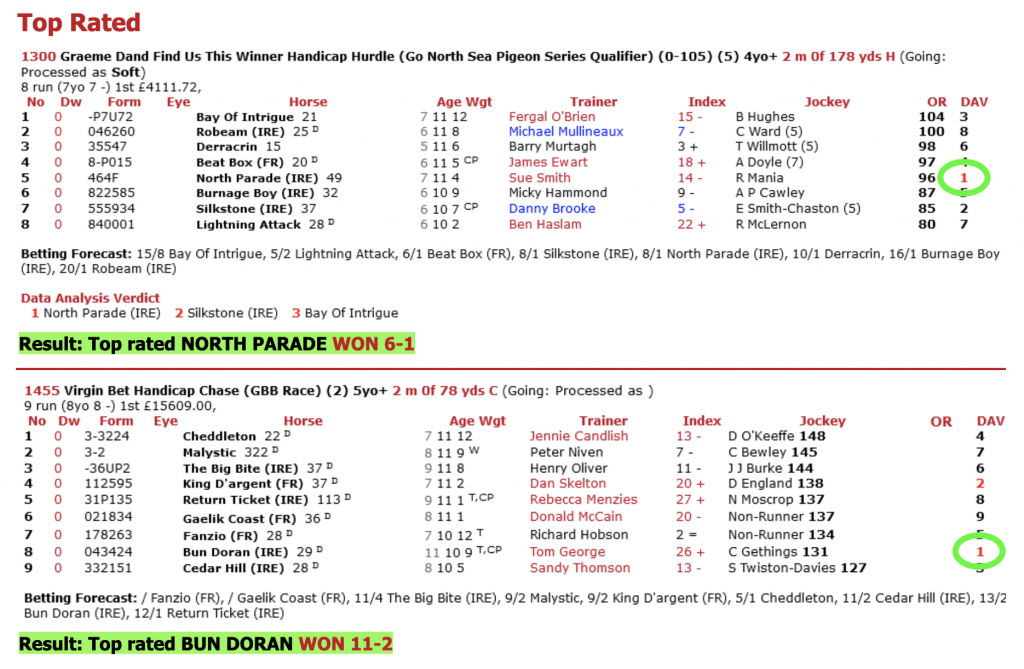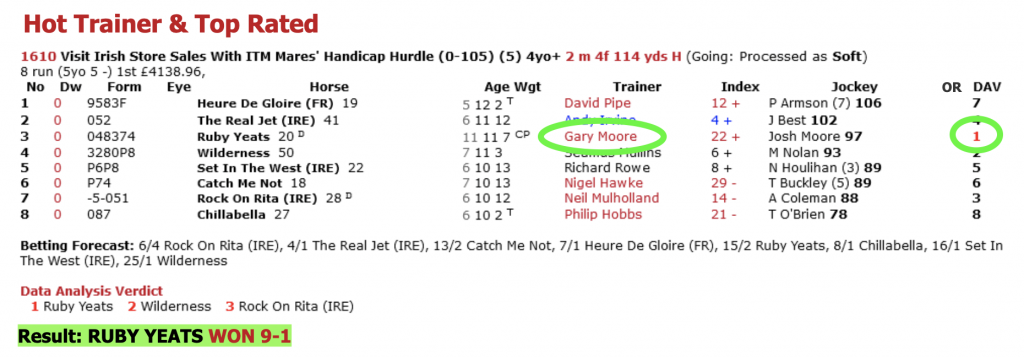Racing Telegraph racecards at first glance may look similar to most other racecards but there are undoubtedly one or two subtle differences that you may want to take account of.
Firstly, lets establish that these will never take the place of good, honest and reliable Inside Information but they can help you to narrow down the options when looking to beat the bookmaker. We would never suggest that you follow the fortunes of the racecards conclusions blindly. There are thirty three years of Racing Telegraph experience in the programming and they are still a work-in-progress but, already, they do posess features which can definitely assist in the perennial battle.
This fully automated system is totally data driven and has been especially created taking into account all the usual factors one would normally monitor when evaluating a race such as: the state of the going, the distance over which they are running and, indeed, both the suitability of the track and, of course, the class of the horse in question. It does not take into account any additional information that we may receive.
So, lets take a look at the features included and how they can help you…
Data Analysis Verdict (DAV)
The first thing to notice is that the racecard system will provide an overall conclusion with the final column providing the Data Analysis Verdict (DAV) and, as a general rule, we would expect, in the absence of any further information, the top two rated horses are most likely to provide the winner. These are indicated in red and are noted beneath each race viz.

A few more examples…

Stable Form and Trainers Index
All stables, contrary to popular belief, endure both periods when their horses are particularly fit and healthy and others when they are decidedly not. This can be completely out of the hands of the trainer when, for example, there may be a virus or ‘coughing’ in the yard. For us, as you might have noticed within the script of our advices, there is absolutely no doubt stables do come into and, go out of, ‘form’. The intention of this section is to provide statistical evidence of both. Naturally that does not mean that all the horses from a stable in form will win nor that all the horses from a stable out of form will lose, but in the quest for the complete and final analysis, you will find this an invaluable asset.
This feature indicates the first difference between our racecards and the more common version. Look at the colour of the Trainers name. What colour is it? If its red, that’s good, that means the Trainers horses are running well, in general while, if it is black, you can assume they’re running well enough if not quite putting the Trainer on the ‘hot’ list but, if blue, then the Trainers is already on, or heading for, the cold list. The index number itself is related to the colour, the higher the number, the better form they are in. Lets look at a couple of examples.

Conversely, just look at the example below, where the hot favourite is from a yard quite unequivocally out of form… he duly finished fourth of the five runners.

There are, of course, occasions when the horse rated top on class, with the going in his favour and at a course that suits him but comes from a yard out of form, how do you recognise this? Well, in the DAV column, you will note the top two rated are usually coloured red but in this instance it will remain black.

Eyecatchers
While the information and bets that Racing Telegraph passes on to its members relies, exclusively, on INSIDE INFORMATION, you may have read within the members enclosure that, from time to time we will, indeed, indicate that we have information in, and lots of it, but we are checking and corroborating the validity of the information before passing it onto you, our members. This checking and corroboration can sometimes include checking the videos of the horses we have been told about to see if the information received is credible. Part and parcel of this process is checking our own files to see if we have seen evidence of a horse’s potential ON THE TRACK and, in order to speed up that process, we do keep a record of some of the horses which have caught our eye in previous races. These are the EYECATCHERS!
We make brief notes of them and although its not unheard of that we might subsequently oppose those horses, particularly when information for something else in the race is stronger, this information is still very valuable and we’ll allow you to see some of the data we keep through the provision of these eyecatchers who will appear on the racecard, together with our notes.
We, generally, make a note of how good the race was, how the race was run, the kind of conditions most likely to suit the horse in question and, when all the ducks are in a row and we can ascertain information about them, in addition, then that’s the time to strike. Equally, with our new highly selective regime where we will provide only the days Best Bets, its entirely possible that the subject of our eyecatchers feature may not even make our top three or four on any given day and then, its entirely up to you if you want to place more bets than we advise on the day, this information may well provide you with the ammunition to do so. In that instance, we are sure you will find this information invaluable. The important thing to remember is that the comments will have been written on the day the horse ran and your interpretation of those comments must bear that in mind. Eyecatchers are denoted by ‘NN’ followed by a rating from 1-3 indicating the calibre we think the horse is capable of, at that time. The range is from 1-3 with 3 being the highest.
Two Year Old Precocity
Two year olds are the babies of the racing world and many observers of the sport find it, quite naturally, very difficult to distinguish between one unraced horse and another. In the early part of the season, for example, you will see whole fields of unraced horses and for many it is a case of ‘where the hell do I start?’
Of course this is where GENUINE INSIDE INFORMATION is absolutely crucial. However, through our unique analysis, created some years ago, we have been able to identify those 2yos most likely to be of a precocious nature and this unique analysis, when allied to our INSIDE INFORMATION, is what has allowed us in numerous seasons to create a significant run of first time out 2yo winners. Indeed, in the season before last we provided eleven consecutive first time out 2yo winners to our members. We are, however, extremely selective and, of course, they won’t all win but if you adopt a similarly selective outlook and, in receipt of the kind of information we can get form the yards, you too can create a sequence of winning 2yo bets from horses making their racecourse debut.
‘PR-1’ would be considered the highest precocity rating.
No examples to show here for this year as yet, of course, as we wont see any two year olds until the start of the flat at Doncaster….but there will be plenty in due course!
